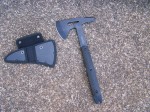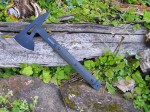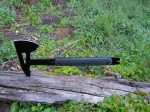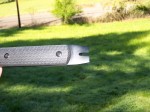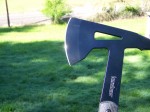Please indulge me for a few minutes, with some of my past. I was raised by my grandparents from the time I was 6-weeks old. The sad thing is that my grandparents had already raised nine kids of their own, and it sure wasn’t fair to them to have to raise me, but that’s the way it was. I had a good life though; I have no complaints. I didn’t realize it, but back then, in the 1950s, my grandparents were dirt poor. When I was younger, they both worked in the same factory on different shifts so one could be home with me. Both stopped working at some point, and my grandfather turned to alcohol to pass the time of day. Still, I had a good life with plenty of friends on my block to play with all the time. Back in those days, no one locked their doors, so it wasn’t the least bit unusual for a neighbor or friend to just open the door and come right into the apartment. It was like that on our entire block back in Chicago.
I’m sure many older SurvivalBlog readers will remember S&H Green Stamps. Many grocery stores, gas stations, and other retail outlets would give you one S&H Green Stamp for every ten cents you spent. You pasted these little stamps into booklets, and when you had enough books filled with those stamps, you went to a department store that contained the S&H Green Stamp outlet. There, you traded the filled S&H Green Stamp booklets for something you found in their catalog. Needless to say, it took a LOT of those little stamps to fill a booklet, and it took many booklets to trade for something. I guess it was something akin to a barter system back then.
When I was six or seven years old, I longed for a hatchet and hunting knife set that I saw in the S&H catalog, and I would help my grandmother paste those stamps into the booklets, until the day came when there were enough filled booklets to take and trade for that hatchet and hunting knife set that I longed for. It was quite the big deal, at that young age, to hop on a CTA bus with my grandmother and go to downtown Chicago to the S&H redemption center to get whatever it was my grandmother could afford to get. Needless to say, she never had enough filled booklets to get everything she wanted. Again, my grandparents were poor, real poor. Many times, my grandmother would send me to the corner grocery store with a quarter to ask for 25-cents worth of baloney for a sandwich. Even at a young age, I knew the store’s owner always gave me more than 25-cents worth of lunch meat. They knew my grandparents were poor. I remiss….
I longed for “that” day, the day when my grandmother and I would hop on the bus and head downtown to trade those stamps for my prized hatchet and hunting knife set. One of my favorite tv shows back then was “Davey Crockett”, and I pictured myself out in the wilds of our backyard, hunting big ol’ bears with that hunting knife and then making a fire using the hatchet to chop some wood. I never stopped to think where the wood would come from. There weren’t any trees on our block! For whatever reason, my grandmother kept delaying heading out that day to get my treasure. Then my grandfather got off the bus. He had gone downtown and got that hatchet and hunting knife for me. I was in heaven!
Needless to say, it was a very cheap hatchet and hunting knife. The knife came dull and so did the hatchet. They had plastic handles on them that was supposed to simulate a bone handle. To this day, you can still find these sets in tourist shops around the country. Still, I was the only kid on the block who had a set-up like this. I never did get around to hunting a bear with the knife, like Davey Crockett did, nor did I ever chop down a tree with the hatchet. I owned that set until I was in my teens, too.
All right, the above is going the long route to introduce SurvivalBlog readers to the new Siege Tomahawk from Kershaw Knives www.kershawknives.com, which I recently received for testing. To be sure, I got the first writer’s sample for testing. I’m here to tell you that this is no cheap toy hatchet. This is a masterfully-made tomahawk for serious survival and, if needed, it’s a weapon of last resort. SurvivalBlog readers are getting a first look at the Kershaw Siege, too!
A little history on the tomahawk is in order, and this goes back to Colonial days or maybe even long before that, if you consider a Native American war club as a tomahawk. In short order, our founders discovered that a tomahawk was not only a great tool to carry, but it was also an excellent weapon. Native Americans back then would trade just about anything to get their hands on a British-made tomahawk, as did many settlers, who wanted a good tool and a weapon of last resort. To this day, many in our military use tomahawks in the field, and there is one company that even sells mil-spec NSN (National Stock Number) tomahawks to our troops. During the Vietnam War, many of our Special Forces carried a tomahawk in the field, too. I’ve mentioned this before; if I were going up against someone armed with a knife, I’d much rather have a tomahawk instead of a knife. Because of the longer reach you have and the power behind a tomahawk when you swing it, it’s devastating, to say the least. Have you seen the movie The Patriot starring Mel Gibson? If so, you saw some serious use of a tomahawk or two by Gibson’s character against the British.
The tomahawk was also used as a throwing weapon, however, I would never throw my weapon away like that. I’m not skilled enough, and most of us aren’t, in the art of throwing a tomahawk. To be sure, there are competitions held all over the country that involve throwing tomahawks, as well as logger axes and knives. Still, I would prefer to keep my weapon in my hand, instead of throwing it at an attacker.
A closer look at the Kershaw Siege shows that this big tomahawk has a double edge blade that is 4-inches long, and I’m here to tell you right now that this thing can easily shave newsprint; it’s “that” sharp. We also have a spike head on the other end that can easily penetrate a skull, without much effort, which is a great way to take out a Zombie! The Siege has a full-tang that is made out of 3Cr13 steel, and it is black oxide coated. Many tomahawks sold today had a wooden shaft or a fiberglass shaft that can break. This won’t happen with the Siege. The handle material itself is glass-filled Nylon scales, which has something called a K-Texture; it’s rubbery and clings to your hand, too. On the end of the handle is a nail-puller, and it can also be used as a pry bar. I’m not sure where a nail-puller comes into play, if you are out in the wilds, but it’s there just the same. The weight of the Siege is 1-lbs 1.6-oz, but it feels heavier, perhaps because of the long shaft. It also comes with a sheath and a belt loop on the back. However, the belt loop isn’t large enough to fit on a military pistol belt, which is a disappointment to me.
When my delivery guy brought the package from Kershaw, he asked what it was. He knew full well that it wasn’t ammo , which he brings me so often. I told him what was in the box and asked him if he wanted to see it. Needless to say, he jumped at the opportunity, and he helped me open (he ripped) the box to get at the contents. He then ripped the Siege out of the blister packaging, too. He was like a kid in a candy store; it is nice! He loved the feel and the balance of the Siege, and I have to agree with him on this point. He announced he was getting one as soon as he could.
I have a small homestead in western Oregon on slightly less than four acres. This is all the land I need, and it’s a lot of work keeping it up, too. We are always having a problem with blackberry vines; they can grow a foot a day when weather conditions are right. Luckily, this time of year they are dormant, but they’re still there. It always serves as a great test to see how sharp a knife is, as many knife blades will either slip off a blackberry vine or simply bend it or break it but not cut it through. The Siege easily sliced right through the blackberry vines. I used the spike head, and it easily penetrated half inch plywood. I could easily chop on fallen trees. The long shaft of the Siege really gives you some power, compared to a shorter hatchet that many campers carry. I even tried my hand at throwing the Siege, and it actually stuck in a tree, many times. Sometimes it would stick by the head, sometimes by the spike, and sometimes by the end with the nail puller. I would suggest, though, if you use the nail puller end that you keep the sheath on the Siege to prevent getting cut by the head of the tomahawk or getting poked by the spiked end should your hand slip.
With the all-steel construction of the Siege, it is a bit heavier than a wooden shaft or fiberglass shift tomahawk, especially compared to those used in throwing competitions. The longer shaft makes the Siege a bit slower in the hand when swinging it. Still, the Siege is an awesome tool and weapon of last resort, in my humble opinion. You simply are NOT going to break this thing, and during all my testing and throwing it I didn’t do any damage to the thing! Wow! It got a little dirty, but it cleaned right up. The only change I’d make is to have a larger belt loop on the sheath so it will fit on a U.S. pistol belt or allow it to attach to MOLLE gear on a backpack. That would be nice.
You can go out and purchase one of those cheap $12 survival hatchets, but they can’t compare to the Siege tomahawk from Kershaw. Quality doesn’t come cheap. However, in this case, the full retail of the Siege is only $79.99, which is quite a bargain, and you’ll never have to replace it; it will last your lifetime. What I would have given to have had a Siege back when I was a kid. There’s not a doubt in my mind that I could have tamed the entire wilderness of Chicago.
– Senior Product Review Editor, Pat Cascio










